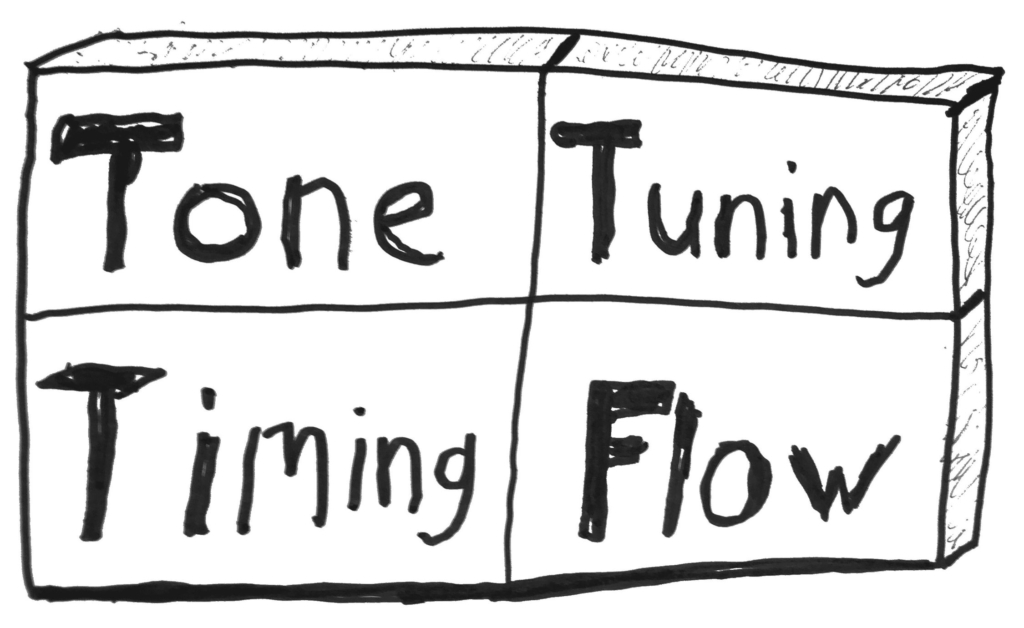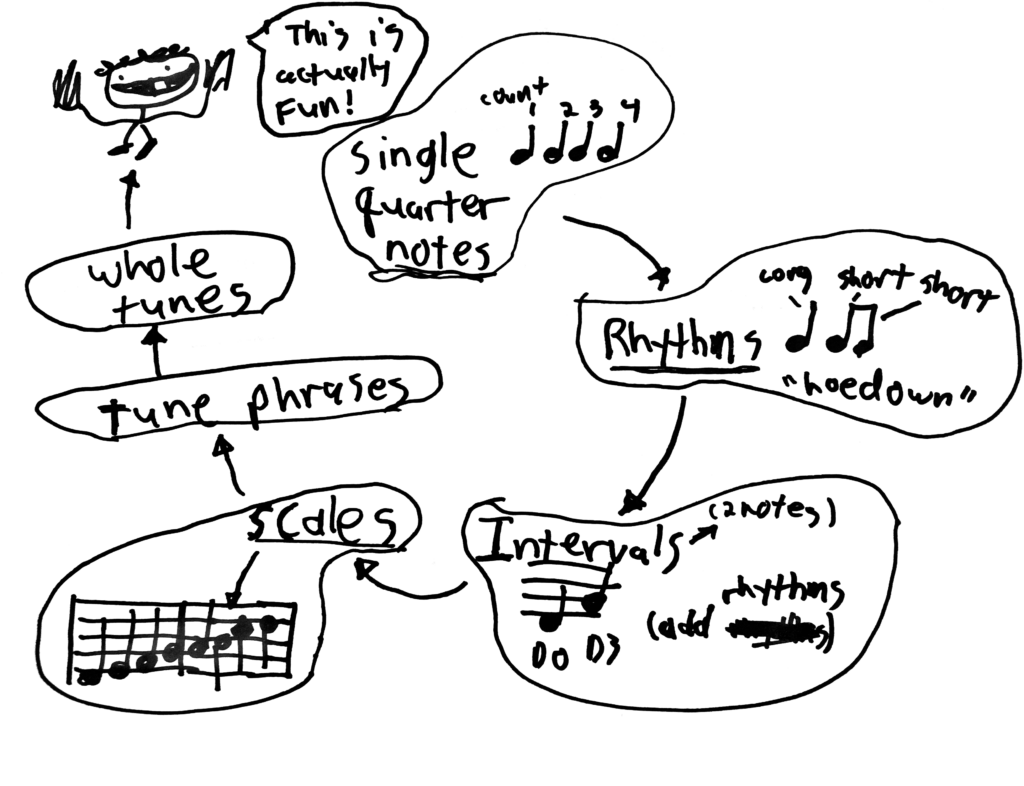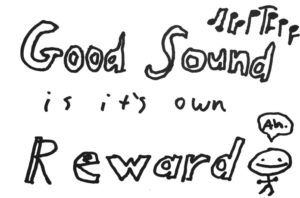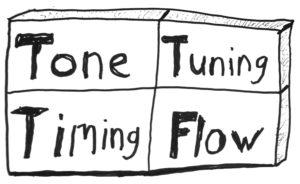What does it mean to have good sound? It seems clear when something sounds bad and when something sounds good. But exactly do we mean by “good sound?” What are the components? Knowing this, how can you improve your sound?
There are four elements to good sound:
- Tone
- Tuning
- Timing
- Flow

Tone is the wholeness and richness of the sound you are producing. A good tone sounds solid, even and beautiful. It’s free of scratching and unwanted skipping. This is the primary component of good sound.
Tuning is a measure of how well in tune each pitch is. To play in tune, you first have to make sure that your instrument is in tune. It may seem obvious, but it’s a mistake I still make even after playing for forty years (because I’m in a hurry to start playing). On guitar and piano, if the instrument is in tune then your playing is automatically in tune. But if you’re playing the fiddle, you have to tune each fingered note yourself. We perceive the music as “sounding bad” when it is out of tune. Non-musicians may not know something is out of tune, but they can sense a decrease in quality.
Timing is a measure of how well the music syncs to the beat, as well as how coordinated the performance is. If the members of a band are not playing in time together, we perceive this as sounding bad. Timing applies to the more granular level of an individual’s coordination. If you need to play D0-3, but your third finger comes down late, it will sound sloppy. Listeners will perceive this too as bad sound.
Flow is a measure of how continuous the music sounds. If you are constantly starting and stopping then the music will be VERY HARD to listen to.
The goal is to make great music and have fun along the way.
With that in mind…
Using Micro-practice to Improve Your Sound
Now that you know what makes up a good sound, let’s make it happen by doing it.

You can practice each of the elements separately by focusing on:
- Single note
- Intervals
- Small (for example, D0-1)
- Wide (D2-A3)
- Scales
- Basic scale (2 bows)
- Variations
- Tunes
- Bits and phrases
- Whole tune
Practicing tone. Start by playing simple quarter notes (1-2-3-4) on an open D string. How good can you make that sound? Then, do the same thing for more complex things. If the sound gets a lot worse, then go back to a simpler thing.
For example, say you work the steps until you are playing the whole tune. But it starts to sound bad. You would pause and try to determine what sounds bad. If you’re not sure, then record yourself. Once you figure precisely the part that’s difficult. Perhaps the fourth quarter of Arkansas Traveller sounds weak.
A3-2-3-0-1-3-0-D3-2-0-1-2-0-0
Work backwards through the steps until you are practicing just two notes: A0-3. Maybe you’ll need to work backward even another a step and practice just A3. When this sounds good you can turn around and work on the entire tune
Go back and forth between a high-level view (whole tune) and a granular view (single note).
Practice tuning. Use the same list above to practice tuning. Practice with one of the following four tuning strategies:
Learn more in this mini-course: How To Play In Tune.
Practice timing. Improve your physical coordination by slowly practicing with bow-stopping, aka “stop-n-rock” or staccato. This trains your fingers and bow to be more precise in the timing of their placement. Use a metronome or play-along tracks to practice coordination with the beat. If you just play on your own without an external clock of some kind, then your timing will tend to drift.
Go to Beat Central for metronomes and beats. Or you can find this the Practice Toolkit at the bottom of the page.
Practicing flow. Practice this once you practiced the first three elements of good sound. You can practice flow by looping on something. Loop practice is one of the most powerful things I teach. If you take one little thing and loop it enough times, it will start to sound like music. Then it’s just a matter of doing this for the other parts of the tune, and then for bigger parts. But usually, if a student is able to play one key part with flow, they also play the rest of the tune with more flow.
Another tip for playing with flow: don’t stop. In this phase of macro-practice, we’re not worrying about small errors. Keep on keeping on until there is a sense of flow. Later, you can return to a more analytical approach by practicing all the trouble spots.
Remember these four elements of sound with the acronym TTTF. I recommend you focus on good sound over learning lots of new tunes. If it sounds good, you’ll gain confidence as well as enjoy the process more. I’m not saying that you should stop learning new tunes. Instead, go deeper with each tune you practice. You can play a simple tune like Oh Susannah your whole life and keep learning from it and practicing new things.
The joy of good sound will keep you practicing and following the path of fiddling. Pick up your fiddle right now and practice this way. Can you get one simple thing to sound good?

Further Learning

Two ways I can help you level up your fiddling
- Sign up for the FiddleHed newsletter below.
- Sign up for the Free Two-week Trial. You’ll get full access to all courses and group lessons. Plus, I’ll send you some free lessons tailored to your current skill level.
Thanks for being here 🙏


The post onTTTF makes practice and what to practice make a little more since to me JDM
This is the second phase of learning a tune…
Hey there jason! Just had a question/idea for ya’ll: think there’s any way to take some of the notes you’ve already recorded, allow them to be randomized, and make a kind of ‘online note generator’?
I LOVE the thought of old-school call and response (think many do), but it’s just not really commonplace these days. And double for these covid-y times. Doing the random part, I think would better allow one to exercise their ear, as opposed to having knowledge of the notes beforehand. Plus it’d be funner.
I’m not a full-fledged member (cheap, cheap bastard here), but i guarantee something like this would get me to join. I’ve searched, and there’s nothing at all on the internet in this regard (violin).
Cheers man!
Hey @tritoned, I love this idea and would love to do it. Right now Ihave a lot of other fish to fry. In the meantime, check out this series of call-and-response games I have on the site: https://fiddlehed.com/how-to-play-in-tune/call-and-response-central/
Hey Jason, totally understand. Many thanks for the response. cheers, jeff
Hi Jason,
Another excellent lesson.
I’m having trouble with my bow wandering. I’ve worked doing slow bowing, scales with various bowing patterns. I choose tunes with a wide range of tempos to challenge myself but try as I might, my bow wanders. Yes, I’ve done the mirror and selfies of me playing. It gets really bad when I’m tired. Do you have any other suggestions as to how I might master this? Of course, when the bow wanders the tone tanks. Thanks.
Ok will try again. PS really enjoying the course!
Great advice. It’s like the Four Horsemen of Music. For me tone is the most elusive; the others are a little more mechanical. To make good music you need all four
Well said! I can see the Four Horsemen riding over the hill…